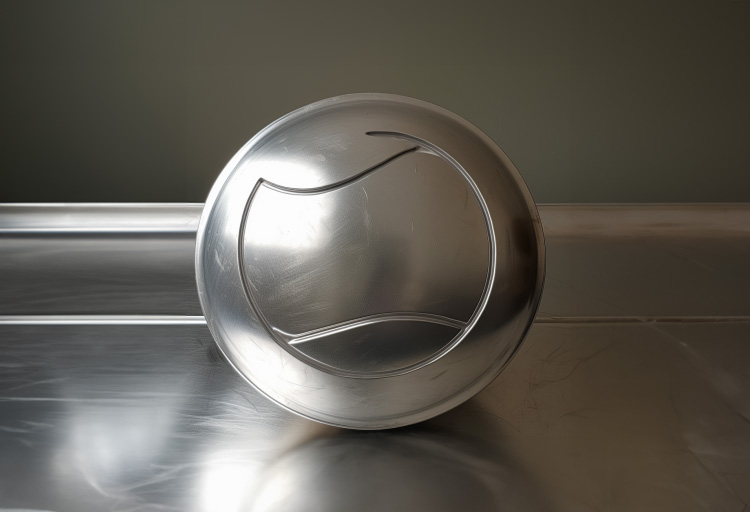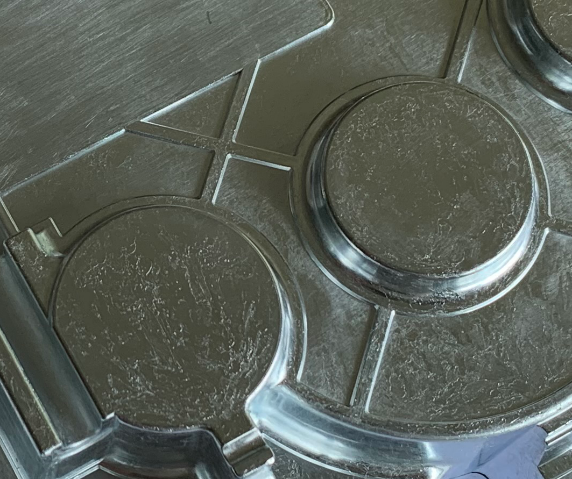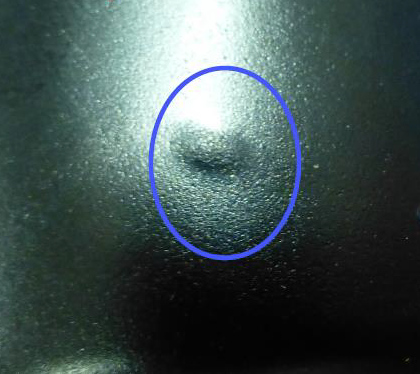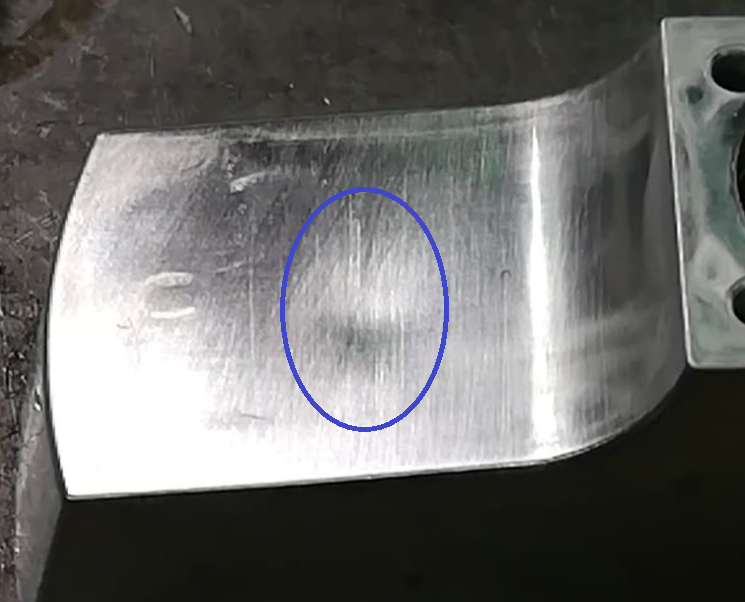As winner of numerous international awards, Bruschi Spa is known for its innovative approach in design and technology. We are glad to share our insights and experiences with the industry members.
Surface defects in zinc die casting: flow marks, blistering and sink

In this post, we will address the main problems concerning the possible casting defects that could arise in the die-casting process and which would compromise the success of subsequent surface treatment. This treatment, which can be a galvanic or a painting, can be carried out for aesthetic and functional reasons.
In both cases, the surface of the die-cast must be in suitable conditions to receive the foreseen treatments. Therefore, it is crucial to avoid defects created on the products during the die-casting process that do not allow the painting treatment or the galvanic coating to adhere correctly to the piece.
Below, we will analyze the primary casting defects that occur during the zinc alloy die-casting process, analyzing the possible causes and the relative remedies to be adopted in the production phase.
Flow Marks
It is the most common defect of the die-casting process and is generated by the cooling of the liquid metal in contact with the surface of the mold during the cavity-filling phase. The surface of the die-cast with flow marks has streaks and veins that reproduce the metal's flow lines, similar to a geographical map. In the injection phase, the zinc alloy comes into contact with the mold in a few moments. It cools abruptly, creating thin superimposed plates that give rise to the characteristic pattern typical of the flow marks on the piece's surface once it has cooled.
Causes of flow marks

The leading causes of marbling are mainly three:
- Excessive mold cavity filling time
- Mold temperature and filling speed are too low
- Improperly designed supply channels
In literature, as in daily foundry practice, it is now clear that it is almost impossible to obtain a die-cast utterly free from this defect: it is, therefore, important to know how to evaluate and define the degree of acceptability. As previously anticipated, an excessive degree of flow marks can cause defects in the painting or galvanic treatment phase due to the irregularities of the surface. The superficial micro-cracks of the flow marks can, in fact, trap gas or air, which are then released in the various phases of the painting or galvanic processes, generating aesthetic defects such as microbubbles, pitting, micro craters, which are not tolerated by both aesthetically and functionally.
Solutions: How to avoid flow marks
The elimination or, at least, the reduction of the marbling problem is obtained through the correct regulation of the main molding parameters: such as the filling speed and the temperature of the mold surface. In this way, it is possible to speed up the filling time, reducing it to a few milliseconds, and avoid the formation of sheets of cold material on the surface of the die-cast.
This type of casting defect can, therefore, already be foreseen in the mold design phase. In fact, a correct analysis using the simulation program allows the design of the injection points and the shapes of the optimal feeding channels to obtain flow rates and filling speeds suitable to avoid thus the problem of flow marks in the zinc die-casting process.
Blistering
Blistering is a porosity defect due to gas trapping within a sub-surface region of the part. This casting defect is characterized by a small surface area that deforms when the internal pressure of the porosity due to the gas under the surface is high enough to distort the thin metal layer that covers it plastically. Generally, the size of the bubbles can vary from 100 µm to several mm.
Causes of blistering

Metal deformation occurs quickly at relatively high temperatures when castings are ejected from the mold or during subsequent heat treatments. This type of defect is mainly attributable to the turbulent filling of the mold and the consequent entrapment of air present in the feed channels and the mold cavities. That is a defect well known to painters since, in the powder coating process, the final phase involves a passage in the oven at temperatures of around 200°C and, at this temperature, any gas or air trapped in the die casts expands and in the case of thin-walled products or air inclusions close to the surface, it generates blistering.
Solutions: how to avoid blisterings
Let's see below what are the different precautions to avoid the onset of this defect:
Analyses
The first activity to be carried out is an in-depth analysis of the data provided by the filling simulation program. In fact, this program makes identifying the product areas at the highest risk of air entrapment possible. Following this information, it is possible to size the injection sections and the supply channels in order to avoid entrapments. The modern machines that are protagonists (Pre-filling, FDS) of the zinc die-casting process are equipped with systems that reduce the introduction of air during the filling phase, obviously reducing the phenomenon but not completely eliminating it.
Vacuum molding
The most important and efficient solution is the use of the vacuum molding system: that is, by extracting the air from the mold cavities before the metal reaches them. This system guarantees a drastic reduction of waste due to the presence of surface bubbles, both in the molding phase and in the subsequent surface treatment phase.
Sink
A sink is a surface depression created during the die castings' cooling phase due to a shrinkage porosity under the surface. This casting defect appears as a concave sink, even of several mm, usually in correspondence with high thicknesses or significant changes in the thickness of the product, and is frequently associated with ribs.
Cause of the sinking phenomenon

It is a phenomenon that occurs when, during the solidification of the casting, a hot spot is found near the surface of the mould: the "skin" layer: it forms as a result of the cooling of the zamak in contact with the mould, it is unable to support the stresses deriving from the contraction of the underlying region in solidification (shrinkage) and therefore plastically deforms.
The effects of this defect translate into imperfections in the finished product.
Solutions to the sink defect
The primary remedy is the correct design of the components, i.e., making sure that there are no significant changes in thickness or areas of the product with excessive thickness. Unfortunately, it is not always possible to create the ideal shape for the functional needs of the product,
It is, therefore, crucial, during the design phase of a new product, to have a close collaboration between the designer and the die caster in order to identify the correct shapes to reduce hollows while respecting the product's functionality.
To avoid sinks during the production process, it is also possible to act on the pressure and speed of the molten metal during the injection phase. Lastly, even more, important is the management of the heat balance of the mould, creating adequate cooling systems to avoid the formation of hot spots. Also, in this case, the cooling simulation analysis helps us identify the areas of the die casting with the most extended cooling times. It allows us to create the most efficient cooling circuit, suitable for avoiding the sink.
In conclusion
As mentioned in the incipit of this post, we have dealt with the main problems concerning possible casting defects in the zinc die-casting process. As previously explained, all issues can be foreseen and solved or defined as acceptable: the important thing is to know how to recognize and prevent them. There are other issues besides flow marks, blistering, and sinks in zinc die casting. Problems to be discussed in depth: look for these topics in our blog.
